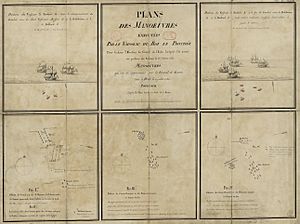Action of 24 February 1780 facts for kids
Quick facts for kids Action of 24 February 1780 |
|||||||
|---|---|---|---|---|---|---|---|
| Part of the American War of Independence | |||||||
 Plan of the movements made by the French ship Protée to protect its convoy while it is attacked by several English ships off Madeira on 24 February 1780. |
|||||||
|
|||||||
| Belligerents | |||||||
| Commanders and leaders | |||||||
| Robert Manners | Du Chilleau de La Roche | ||||||
| Strength | |||||||
| 3 ships of the line | 2 Ships of the line 2 Frigates Convoy of 20 transports |
||||||
| Casualties and losses | |||||||
| unknown | 1 ship of the line captured, 3 transports captured & 1,000 prisoner of war |
||||||
The Action of 24 February 1780 was a small naval battle. It happened near the island of Madeira during the American Revolutionary War. A group of French supply ships, called a convoy, was sailing when British warships found them. The British chased the French, and in the end, the French warship Protée was captured. Three other French supply ships were also taken.
Contents
What Happened?
Setting the Scene
In early 1780, the Royal Navy (Britain's navy) was very active. Admiral George Rodney was a famous British commander.
A French convoy left Lorient, France, on February 16, 1780. This convoy was carrying soldiers and supplies. They were heading all the way to India. The main warship protecting them was the 64-gun Protée. Captain Du Chilleau de La Roche commanded the Protée. He was in charge of the whole convoy. Other ships like the Ajax and Charmante were also part of the escort.
The Battle Begins
On February 23, the French convoy was near Madeira. Suddenly, they saw Admiral Rodney's British fleet. Captain Du Chilleau de La Roche knew his convoy was in danger. He made a brave plan.
He ordered the Ajax and most of the supply ships to turn back and escape. Meanwhile, he would keep the Protée and a few smaller ships sailing forward. His goal was to trick the British fleet into chasing him. This would give the rest of the convoy time to get away safely.
The British fleet fell for the trick and chased the Protée. Captain Du Chilleau de La Roche succeeded! The Ajax and most of the convoy escaped.
The Chase and Capture
Around 1 AM, Captain Du Chilleau de La Roche tried to escape himself. But the Protée had bad luck with the wind. Her sails and masts were damaged. This allowed the British ship HMS Resolution to catch up around 2 AM. Soon, two more powerful British ships, HMS Bedford and HMS Marlborough, joined the chase.
The Protée was now greatly outnumbered and outgunned. Captain Du Chilleau de La Roche had no choice but to surrender his ship. The French frigate Charmante managed to get away and returned to France. The British also captured three of the French merchant (supply) ships.
After the Battle
What Happened to the Captain?
Captain Du Chilleau de La Roche was put on trial for losing his ship. However, the court decided he had acted bravely and honorably. He was found innocent.
British Gains
The British gained a lot from this battle. Besides the three supply ships, the Protée was carrying a large amount of silver. This silver was shared among the British sailors as prize money.
The captured French ship Protée was then added to the British Royal Navy. It was renamed HMS Prothee.
Images for kids


